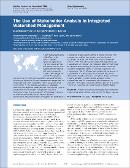| dc.contributor.author | Mutekanga, Fiona Proscovia | |
| dc.contributor.author | Kessler, Aad | |
| dc.contributor.author | Leber, Katia | |
| dc.contributor.author | Visser, Saskia | |
| dc.date.accessioned | 2022-02-02T10:31:50Z | |
| dc.date.available | 2022-02-02T10:31:50Z | |
| dc.date.issued | 2013-05-01 | |
| dc.identifier.citation | Mutekanga, Fiona Proscovia...et al (2013). The use of stakeholder analysis in integrated watershed management. Mountain Research and Development. https://doi.org/10.1659/MRD-JOURNAL-D-12-00031.1 | en_US |
| dc.identifier.uri | https://doi.org/10.1659/MRD-JOURNAL-D-12-00031.1 | |
| dc.identifier.uri | https://kyuspace.kyu.ac.ug/xmlui/handle/20.500.12504/346 | |
| dc.description | 2012 | en_US |
| dc.description.abstract | In the Ngenge watershed, at Mt. Elgon in the eastern Ugandan highlands, agricultural practices cause serious soil erosion problems and subsequent decrease in soil and water quality. Attempts to manage soil erosion through policy interventions have not been successful, because existing policies and legislation for natural resource management are inadequate and often formulated without consulting local communities. In the Ngenge watershed, an integrated watershed management (IWM) program was initiated to foster sustainable land and water management solutions. Experience shows that successes in IWM programs depend on effective participation by all relevant groups of stakeholders. The present study investigates the usability of a stakeholder analysis (SA) and how it has to be linked with participatory problem identification and participatory formulation of action and work plans to build a base for effective IWM. The SA considered the following criteria: (1) stakeholders' commitment to implement IWM, (2) their power to influence policy-making and implementation processes, and (3) the expected impact of the IWM program on the stakeholders. The SA allowed identification of key groups of stakeholders who participated in workshops and jointly developed concrete action and work plans. These workshop outputs, together with the positive feedback of the stakeholders and the commitment of policy-makers to continue the process, are good indicators that SA is a useful means for supporting the development of IWM strategies. | en_US |
| dc.language.iso | en | en_US |
| dc.publisher | Mountain Research and Development. | en_US |
| dc.subject | Stakeholders | en_US |
| dc.subject | Integrated watershed management | en_US |
| dc.subject | Stakeholder analysis | en_US |
| dc.subject | Key stakeholders | en_US |
| dc.subject | Policy-making | en_US |
| dc.subject | Mt. Elgon | en_US |
| dc.subject | Uganda | en_US |
| dc.title | The use of stakeholder analysis in integrated watershed management | en_US |
| dc.type | Article | en_US |

